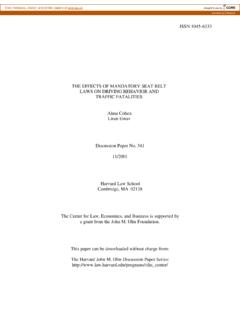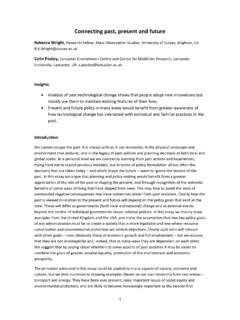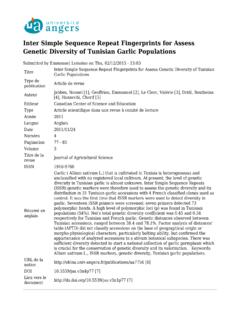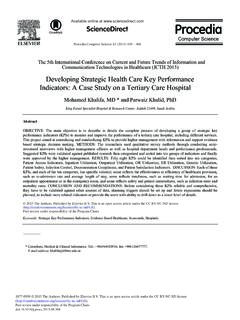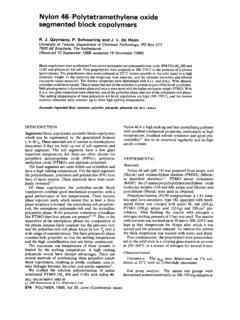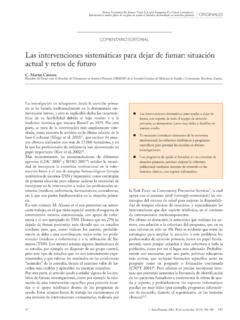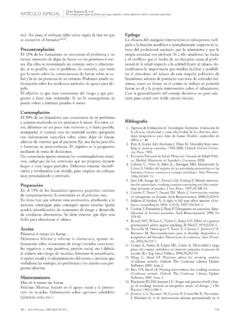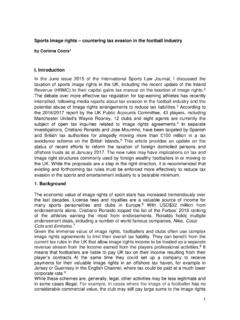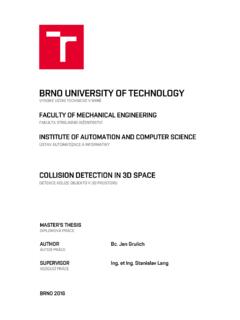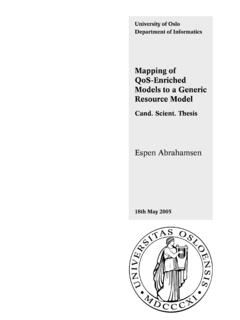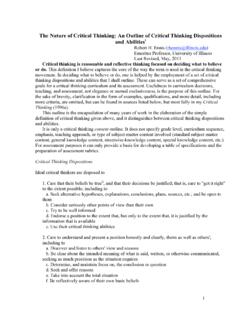Transcription of THE IMPACT OF LEADERSHIP STYLES ON EMPLOYEE …
1 THE IMPACT OF LEADERSHIP STYLES ON EMPLOYEE ENGAGEMENT IN A LARGE RETAIL ORGANISATION IN THE WESTERN CAPE WENDY OLIVER Mini-thesis submitted in partial fulfillment of the requirements for the degree of Magister Commercii in the Department of Industrial Psychology, Faculty of Economic and Management Science, University of the Western Cape SUPERVISOR: RUKHSANA JANO NOVEMBER 2012 DECLARATION I hereby declare that the The IMPACT of LEADERSHIP STYLES on EMPLOYEE engagement in a large retail organisation in the Western Cape is my own work, that it has not been submitted for any degree or examination at any other institution of higher learning and that all the sources I have used or quoted have been indicated and acknowledged by complete references.
2 It is being submitted for the degree of Magister Commercii at the University of the Western Cape. Full Name: Wendy Oliver Date: November 2012 Signed: .. i ACKNOWLEDGMENTS To the one and only God, Jesus Christ, thank you for your grace and loving0kindness that has carried me through a challenging year. The completion of this thesis would not have been possible without your daily strength. You are the Oasis of my life. To my dear parents, Donald and Glenda Oliver, thank you for believing in me and always cheering me on in life. Your love and support has made me the person that I am. Your wisdom and sacrifice to educate me will carry on for generations to come.
3 Then, to the special ladies in my life that have carried me in their prayers namely, Sandy Corneilse, Candice Booysen and Abigail Milton, you are undeniably worthy of being mentioned. My brother, Lindsay Oliver, the rest of my family, all my friends and supportive colleagues, you are loved. To my supervisor, Rukhsana Jano, for your expert guidance and support, thanks for encouraging me to complete this thesis. To Karl Heslop, for believing in my ability and being a voice when it was most needed, you are a blessing to us all. Lastly, a big thank you to the HR Department of this organisation for the consent granted to conduct the research and for all the respondents that kindly participated.
4 Ii ABSTRACT In today s ever0changing, globally0competitive and volatile market, LEADERSHIP is probably one of the most significant contributors that determine the success or failure of an organisation. Fundamental to this, is the way in which leaders are able to engage their employees. EMPLOYEE engagement has therefore emerged as a critical topic which can be defined as a positive and fulfilling work0related state of mind characterized by vigour, dedication and absorption (Schaufeli & Bakker, 2004). Research indicates its significance to positive work outcomes such as high productivity levels, increased job satisfaction , low turnover and overall improved business results that all ultimately contributes toward bottom line (Harter, Schmidt & Hayes, 2002).
5 To gain further insight, the purpose of this study was to investigate the IMPACT of LEADERSHIP STYLES , particularly the IMPACT of transformational and transactional LEADERSHIP on EMPLOYEE engagement. Within a business context, transformational leaders are those extraordinary individuals that have the ability to capture their employees attention, intellectually stimulate them and strategically align them with the vision and mission of the organisation. Contrary to this, is transactional LEADERSHIP which is basically an exchange relationship between the leader and EMPLOYEE whereby the leader exchanges rewards and/or incentives for performance.
6 Both STYLES of LEADERSHIP are instrumental in engaging employees within the organisation, although a plethora of literature suggests that transformational LEADERSHIP impacts more significantly on EMPLOYEE engagement (Schaufeli & Bakker, 2004). iii For this study a quantitative research design was applied using a sample of 104 employees in a retail organisation that all had someone they reported to. Participants were requested to complete the Multifactor LEADERSHIP Questionnaire, the Utrecht Work Engagement Scale and a biographical questionnaire. Pearson correlations were computed to investigate the relationship between the variables.
7 Results indicate that there is a statistically significant relationship between both LEADERSHIP STYLES and the overall dimensions of EMPLOYEE engagement (namely, vigour, dedication and absorption). Transactional LEADERSHIP however, did not have a positive influence on vigour. Comparing the two LEADERSHIP STYLES , transformational LEADERSHIP played a greater role in predicting EMPLOYEE engagement as opposed to transactional LEADERSHIP . In light of the above, this study added to existing literature by providing insight into the strength and direction of relationships amongst these variables. Furthermore, it also provides valuable information for organisational leaders seeking to engage their employees.
8 Limitations and recommendations of this study also present insights into the possibilities that could be explored for future research. KEY WORDS Transformational LEADERSHIP , transactional LEADERSHIP , EMPLOYEE engagement, vigour, dedication, absorption, inspirational motivation, idealised influence, individual consideration, intellectual stimulation iv LIST OF FIGURES Figure Basic LEADERSHIP Approaches 13 Figure Studies of LEADERSHIP Traits and Characteristics as 15 Postulated by Various Researchers Figure Maslow s Hierarchy of Needs 24 Figure Gender of Respondents 77 Figure Age of Respondents 78 Figure Race of Respondents 79 Figure Education Level of Respondents 80 Figure Tenure of Respondents 81 Figure Type of Employment 82 Figure Job Title of Respondents 83 Figure Dimensions of Work Engagement 85 v LIST OF TABLES Table
9 Means, Standard Deviation, Minimum and Maximum 84 Scores for the Dimensions of EMPLOYEE Engagement Table Pearson s Correlation Matrix between the Dimensions 86 of Work Engagement and Transformational LEADERSHIP Table Pearson s Correlation Matrix between the Dimensions of 87 Work Engagement and Transactional LEADERSHIP Table Stepwise Regression for Work Engagement, Transactional 88 and Transformational LEADERSHIP Table Cronbach s Coefficient Alpha for the Dimensions of the 89 UWES Questionnaire as well as for the MLQ vi TABLE OF CONTENTS PAGE NO Declaration i Acknowledgments ii Abstract iii List of Figures v List of Tables vi CHAPTER 1.
10 INTRODUCTION AND PROBLEM STATEMENT Introduction 1 Motivation for the Study 4 Research Objectives 6 Research hypotheses 7 Definition of Constructs 7 Transformational LEADERSHIP 7 Transactional LEADERSHIP 8 EMPLOYEE Engagement 8 Summary of the Chapter 9 Overview of the Study 9 CHAPTER 2: LITERATURE REVIEW Introduction 11 LEADERSHIP Defined 12 LEADERSHIP Theories 13 Trait Theory 14 Behavioural Theory 16 Ohio State and University of Michigan Models 17 Blake and Mouton s Managerial Grid 18 Theory X and Theory Y 18 Contingency Theory 19 Fiedler s Contingency Model 20 Hersey and Blanchard s Situational LEADERSHIP Model 20 House s Path0 Goal Model 22 Leader0 Member Exchange Theory 22 Full Range LEADERSHIP Approach 23 Transformational LEADERSHIP Defined 23 Benefits of Transformational
